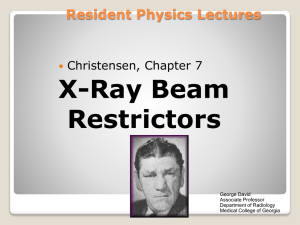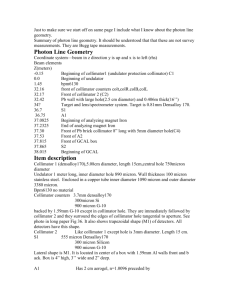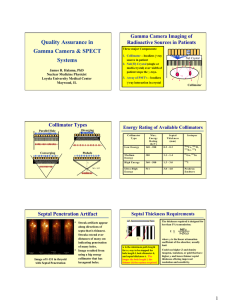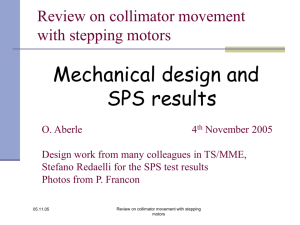Modeling a flexible Detector Response Function in small animal
advertisement
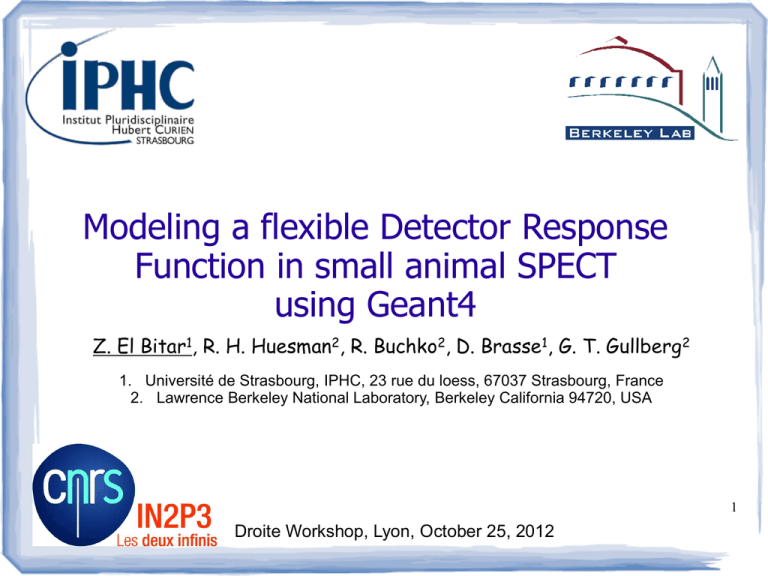
Modeling a flexible Detector Response
Function in small animal SPECT
using Geant4
Z. El Bitar1, R. H. Huesman2, R. Buchko2, D. Brasse1, G. T. Gullberg2
1. Université de Strasbourg, IPHC, 23 rue du loess, 67037 Strasbourg, France
2. Lawrence Berkeley National Laboratory, Berkeley California 94720, USA
1
Droite Workshop, Lyon, October 25, 2012
Outline
1. Context
2. Fully 3D image reconstruction
3. Monte Carlo modelling of the system matrix
4. Including geometrical misalignment
5. Correcting for penetration
6. Phantom and preclinical results
2
Single Photon Emission Computed
Tomography
1- Injection of a radiotracer
2- Isotropic emission of gamma rays
3- Collimation: Filtering the
directions of the photons
Parallel
Pinhole
Parallel
Pinhole
3
Fully 3D image reconstruction
Projection p
Activity
distribution
f
detector
i
j
Discrete formulation of the image reconstruction problem
p=Rxf
R(i,j) : Probability that a photon emitted in a voxel i to ba detected in a pixel j
1. Simultaneous reconstruction of the whole volume
2. Taken into account of 3D physcial phenomena such as : scatter
and detector response
• Solving p = R f using an iterative method like MLEM, OSEM, ART, GC.
4
Modélisation Monte Carlo de R
Modèle du TEMP
Coupe voxellisée (obtenue par TDM)
1
2
• densité
• composition atomique
Modélisation Monte-Carlo des
probabilités qu’un photon émis
en voxel i soit détecté en pixel j
3
j
i
détecteur
mesures
TEMP
P
Données fonctionnelles
TEMP (fusion avec TDM)
5
Résolution du problème inverse P
= Rx f
dans un algorithme itératif
(ML-EM, OSEM, ART, CG …)
4
Estimation de R
5
What’s the problem in small animal
SPECT ?
1. Monte Carlo simulations are time consuming.
2. Detection efficiency is very low in small
animal SPECT due to pinhole collimation.
3. Pinhole SPECT modality is very sensitive to
geometrical misalignments => a system
matrix should be computed for each set up.
4. We must find a solution to avoid resimulation
by Monte Carlo methods for each exam =>
need to have a detector model independent
of the acquisition set up.
6
Decomposition of the system matrix
R = Rsubject + Rdetector
To be computed for each subject/exam
Computed once-for-all
7
Definition of a family of lines (or directions)
pixel j
crystal
collimator
bin i
The family of lines Lij is defined by all photons’ directions entering the collimator
at bin i and aiming the crystal’s pixel j => Calculation of the Detector Response
function table (DRFT).
8
SPECT Components
Rectangular knife edge collimator
Aperture : 2 x 1.5 mm2
Rectangular knife edge collimator
Aperture : 0.6 x 0.4 mm2
Both collimators
Shielding
SPECT : General Electric – Hawkeye 3
9
SPECT model in Geant4
Collimator
Collimator + shielding
Collimator + Shielding + Crystal
10
Validation of the DRFT
Profiles drawn on the projections of three point sources located at :
(-20 mm, 0, 0), (0, 0, 0) and (20 mm, 0, 0).
Speed up by a factor of 74
11
Pinhole acquisition geometry
7 parameters to estimate:
• m : mechanical shift
• electronic shift : eu , ev
• distance collimator to centre of rotation : r
• distance collimator to crystal : f
• Tilt and Twist angle: Ф, Ψ
Calibration parameters are estimated by
minimizing the following functions :
12
Calibration phantom
1
2
3
13
Geometrical Parameters Estimation
1
u (head1)
v
v (head1)
3
2
u (head2)
v (head2)
u
14
Trajectories' fit
Head1
Head2
15
Mechanical
shift
y
crystal
shift m shift m
collimator
x
s
Reconstructed Images of a sphere (Ø = 2 mm).
z
16
Original
m = 2 mm
Corrected
What’s the point ?
1. After performing Monte Carlo simulations and
calculating a Detector Response Function Table,
one is home-free to used the DRFT(~500 Mbytes).
2. The DRFT can incorporate with ease for any
geometrical misalignments (translation, rotation): all
what is required is the equation of the entry plan
(collimator) and the detection plan (crystal).
3. Resimulation of all photons’ trajectories inside the
detector is not required for each study.
17
y
Target emission window:
x
z
{x > -1; x < 1}
{z > -1; z < 1}
{x > -3; x < 3}
{z > -3; z < 3}
Target window = 2 mm
Target window = 6 mm
{x > -3; x < -1} U { x > 1; x < 3 }
{z > -3; z < -1} U { z > 1; z < 3 }
Penetration window
18
Penetration validation
tung(140keV ) 3.6m m1
x
d
d x tg
2
α
Penetration ratio
0,6
d effective d geo (d geo
2
tg ( ))
tg 2 ( )
2
2
2
2
Penetration ratio
0,5
0,4
Theory
Geant4
0,3
0,2
0,1
0
0,1
0,2
0,3
0,4
0,5
Distance from the knife edge border (mm)
deffective(w (140keV ) : 3.6m m1, d geo : 2m m, 90deg) 2.29m m
19
*Roberto Accorsi and Scott Metzler : Analytic Determination of the Resolution-equivalent effective diameter of a Pinhole
Collimator (IEEE, TMI, vol 23, June 2004)
Penetration effect : simulation study
Projection of Cylindre : Diameter = 40 mm, Height = 40mm
Target window = 2 mm
Target window = 6 mm
Penetration window
20
Tomography
• Spatial resolution:
Rsystem
R2
int R 2
geo
2
M
Where:
• Rint is the intrinsic spatial resolution of the crystal
• Rgeo is the spatial resolution due to the geometry of the pinhole
• M is the magnification factor (distante detector-pinhole)/(distance pinhole-centerFOV)
1
Rgeom etry d (1 )
M
Where:
• d is the diameter of the aperture of the pinhole
Expected radial spatial resolution with:
Wide collimator (2 x1.5 mm2) : 2.55 mm
Narrow collimator (0.6 x 0.4 mm2) : 1.14 mm
21
Effect on reconstruction
Window projection : 2 mm
Window system matrix : 2 mm
Window projection : 2 mm
Window system matrix : 6 mm
22
Window projection : 6 mm
Window system matrix : 2 mm
Window projection : 6 mm
Window system matrix : 6 mm
Real data: micro Jaszczack phantom (1)
4.0 mm
4.8 mm
1.2 mm
3.2 mm
2.4 mm
1.6 mm
23
Real data: micro Jaszczack phantom (2)
2 mm
Correction for the penetration effect
1.5 mm
Window system matrix : 2 mm
Window system matrix : 6 mm
24
Real data: micro Jaszczack phantom (3)
0.6 mm
0.4 mm
Misalignment correction
Before correction
After correction
25
Computation time : parallelization of
the system matrix calculation
Computation time for an object of
152x152x152 voxels ~= 20 minutes
Each processor calculate the system
matrix corresponding to a slice
Field of view
26
Parallelization of the iterative
reconstruction
Reconstruction Tomographique
Slaves tasks:
Slave
1. Forward-projection
2. Send projections
PC 1
PC 2
6/7
2/3
2/3
6/7
2/3
PC 10
6/7
7. Receive CC
8. Back-projection
Master Tasks
3. Receive projections
Volume’s slices
to be reconstructed
4. Sum the projections
Master
5. Compute the correction coefficients
(CC = Pmeasured/ Pestimated)
6. Send the CC to the slaves
27
Most recent result
150x150x150 voxels (0.4x0.4x0.4 mm3),
90 projections (128x88 pixels)
Size of system matrix ~= 40 GBytes
MLEM (50 iterations) < 3 minutes
0.6 x 0.4 mm2
28
Small animal result
Reconstruction slice of a
rat heart using MIBG
(ML-EM, 50 iterations)
Profile drawn through the heart
El Bitar et al, submitted to Phys Med Biol
29
Acknowledgment
Grant T Gullberg (discussion)
Ronald H Huesman (discussion)
Rostystalv Boutchko (calibration)
Archontis Giannakdis (discussion)
Martin Boswell (computing)
Nichlas Vandeheye (experiments)
Steven Hanrahan (experiments)
Bill Moses (experiments)
Special thanks to the Franco-American
Fulbright-commission !
30

